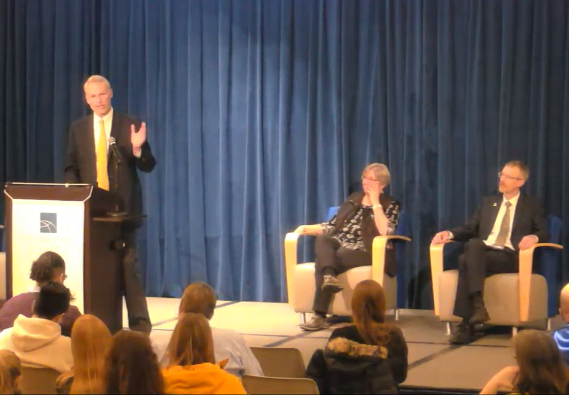
Alaska’s University system has been transforming through the last five years of reductions. The statewide administration is smaller, there are fewer degree programs offered and about 1,200 jobs have been cut or unfilled. The one institution has three separately accredited universities and thirteen community campuses. UA President Jim Johnsen gave his fourth “State of the University” address on Tuesday, showcasing achievements and listing challenges. Johnsen also talked about funding woes.
Johnsen covered the typical highlights you’d expect from a university president’s address: commencements at rural campuses, a Rhodes scholarship – the first one from Alaska, awards from the Department of Defense and the National Science Foundation, and the financial impact on local communities.
But he focused on the things that make UA different.
“UA research is nothing short of world class,” Johnsen said. “As the number 1 Arctic research university on the planet — not Harvard or Berkeley — the University of Alaska leads the pack in understanding the North in its physical and social importance to the entire planet. Moreover, we are beginning to see the fruit now of investments made in prior years in the commercialization of our intellectual property.”
Johnsen listed the big research arms Alaska Center for Energy and Power, the Arctic Domain and Awareness Center, the Institute of Social and Economic Research and the College of Fisheries and Ocean Sciences.
“Our research not only expands our knowledge about our world, it brings us unparalleled financial returns,” Johnsen said. “For each state dollar we invest, our researchers bring in $6 from outside the state.”
The average age of the 26,000 UA students is 30 years. Not only older, but Alaska students tend to work while they are in school and many support families. They also tend to take longer to finish their programs than students elsewhere.
Johnsen mentioned challenges, such as UA never got the land grant it was allocated, and he thanked the Dunleavy administration, the legislature and the federal Department of Interior for working on that.
Another problem: He called the recent loss of accreditation at UAA’s School of Education “a failure.”
“Our recent loss of accreditation of the initial teacher licensure programs at UAA is most certainly a failure,” Johnsen said. “Fortunately for our students, with strong support from UAA, UAF and UAS stepped in to make sure students in Anchorage have a certain path to teacher licensure from an accredited and approved program.”
Next month the Regents will decide if the Anchorage programs should try to get their accreditation back or just let Anchorage students continue their programs remotely through UAF or UAS.
And of course, Johnsen talked about this year’s state budget cut of $134 million, or 41 percent of state funding, from $327 million.
“These cuts hurt UA and they harm Alaska’s ability to grow the highly trained workforce we need to be economically competitive with other states,” Johnsen said.
He took a dig at the way the state administration is accounting the university, comparing it to other state-funded colleges.
“We are compared to universities that are large and in a single location, giving them the advantage of scale,” Johnsen said. “And our own universities are compared to each other, despite the fact that they are all three quite different in their mission, location, size, mix and levels of degree programs and research and outreach activities. In response to those critics who throw averages around, I ask you is there anything about Alaska that is average”
Johnsen did not go into scenarios if the university’s funding is drastically cut, as he has in other speeches and letters.




